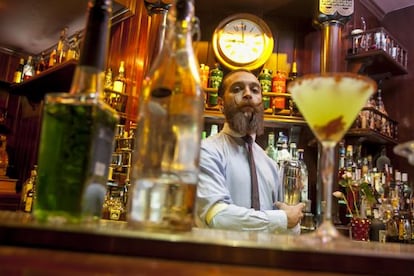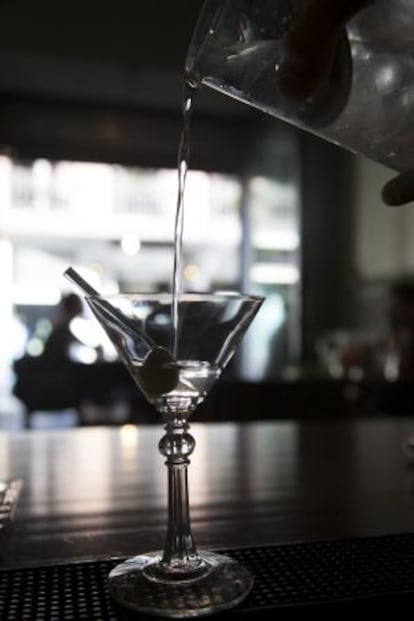Madrid’s best new cocktail bars
A clutch of contemporary drinking spots have found their place alongside the city’s classics

What is it about Madrid’s water that produces such good ice cubes? And such good barmen? In the last few years, economic crisis be damned, the capital has seen a clutch of new first-rate cocktail bars come join the great classics such as El Chicote, Del Diego, Cock, the bar at the Palace Hotel, the Glass Bar at Hotel Urban, and the now-defunct Balmoral.
Let us begin with the most veteran of the newcomers: José Alfredo (C/ Silva, 22), which was opened by four Argentineans running away from their country’s “corralito,” a block on cash withdrawals imposed by the government in 2001. Two of the four partners still remain behind the bar, Ezequiel and Andrés. Their idea was to move away from the classic cocktail bar formula and try to attract film, music and theater types to their place, which is located in the downtown neighborhood known as Triball (as in Triangle Below Ballesta, a local take on New York’s Tribeca).
In the 10 years that have elapsed since then, the partners have more than achieved their goal. José Alfredo is now a leading figure in Madrid nightlife and its patrons include the likes of musicians Jorge Drexler and Spain’s future king and queen, Prince Felipe and Princess Letizia. The 70s-inspired decor seems to beg customers to stay late, or else hop over to the Berlín Café, which is under the same management.
The Dry Cosmopolitan bar’s soft carpeting will cushion the fall after your fifth gin-tonic
Next stop: Dry Cosmopolitan inside the Fénix Hotel (C/ Hermosilla, 2). A sibling of Barcelona’s legendary Dry Martini bar, it opened just three years ago. The bar distils a sophisticated, British-style air and comes complete with soft carpeting to cushion the fall after your fifth gin-tonic, although such behavior is unlikely among a cool clientèle that features American men wearing sunshades at two in the morning and Mexican ladies who show no signs of ever needing anything as mundane as sleep, even if it is 3am. The summer terrace that opens up on to Plaza de Colón makes this one of the few cocktail bars with open-air facilities.
On to 1862 Dry Bar (C/ Pez, 27). Many people are sure to have noticed this bright, decadent little mirage that looks for all the world like an opera stage that somebody plonked down in the middle of the Malasaña neighborhood. Alberto Martínez opened it a couple of years ago in a building that dates back to 1862, and his goal was to rediscover the essence of the primeval cocktail: no fruit, just “alcohol, sugar, water and bitter,” as Jerry Thomas defined it for the first time in history back in (you guessed it) 1862.
The drinks menu has a different cocktail for every hour of the day, beginning with the aptly named Eyeopener. There is also a secret drinks list that you have to specifically ask for, whose contents can be enjoyed either down in the basement or up on the top floor, staring out of the large windows.

Harvey’s (C/ Fuencarral, 70) stands out for its 1940s decor that pays tribute to the golden days of Hollywood and, in particular, the movie of the same name in which James Stewart starred as a man who liked going for dry martinis with his invisible giant rabbit. The place opened a couple of years ago, and owner Eduardo Gutiérrez has come up with new alcoholic combinations such as the 3 de octubre (mezcal and cardamom). It also does food – a good idea before moving on to the drinks. Cajun dishes such as green fried tomatoes are served in booths with shiny red seats.
Kona Lei (C/Hernán Cortés, 8) is one of the few, if not the only, tiki bar in the capital that serves fresh fruit juices and home-made syrups in its drinks. The place belongs to Miguel Ángel Escobedo, a passionate fan of all things tiki who collects crazy totem-shaped glasses that he picked up from some of the 150 Hawaiian-themed bars that used to dot Madrid in the 1970s. The Kona Lei occupies the same premises as the secret bar in the aparthotel on Hernán Cortés street once did in the 1980s. The blowfish lamps and Moai heads recreate the aquarium-like atmosphere of the original bars of Donn Beach, in 1950s San Francisco. Enjoy a Mai Tai or a Zombie as surf music plays in the background, or the Daytonas play a live gig.
The O’Clock (C/ Juan Bravo, 25) is now under the management of Narciso Bermejo, an Edwardian-looking type who wears starched shirts and suspenders, and whose presence represents a good pinch on the well-heeled ass of Madrid’s Salamanca neighborhood. The entire concept of the cocktail is being reinvented within its walls, where traditional dishes come out looking like alcoholic drinks while preserving the essence of the original flavor. One example: the Rabo de Toro, normally a classic dish made with ox tail.
Narciso started his career at age 12, serving beers at his parents’ bar, and here he is now, personally preparing a gazpacho cocktail at a customer’s table or drying out Jabugo ham for a ham-and-melon special amid the Tiffany lamps and Victoria & Albert clocks.
At O’Clock, traditional dishes come out looking like alcoholic drinks while preserving the original flavor
Charly’s, located above a restaurant called La Moraga, opened barely six months ago. Its owner, Carlos Moreno, previously of the Urban bar and the O’Clock, takes a good five minutes to prepare an Old Fashioned, aided by an hourglass and an imperial coffee spoon. Moreno still recalls his first daiquiri at Cock bar, where he was given the following words of wisdom: “A waiter has to make himself invisible. A barman has to get himself noticed.”
And Carlos is certainly noticeable inside his elegant bar with the soft jazz music that is not so loud that it drowns out the conversations. At three in the morning sharp he plays the classic children’s television song Vamos a la cama (Let’s go to bed), to encourage the last customers to take their leave and get some rest before starting all over again with a Bloody Mary for breakfast.
Esther García Llovet is the author of Mamut
Tu suscripción se está usando en otro dispositivo
¿Quieres añadir otro usuario a tu suscripción?
Si continúas leyendo en este dispositivo, no se podrá leer en el otro.
FlechaTu suscripción se está usando en otro dispositivo y solo puedes acceder a EL PAÍS desde un dispositivo a la vez.
Si quieres compartir tu cuenta, cambia tu suscripción a la modalidad Premium, así podrás añadir otro usuario. Cada uno accederá con su propia cuenta de email, lo que os permitirá personalizar vuestra experiencia en EL PAÍS.
¿Tienes una suscripción de empresa? Accede aquí para contratar más cuentas.
En el caso de no saber quién está usando tu cuenta, te recomendamos cambiar tu contraseña aquí.
Si decides continuar compartiendo tu cuenta, este mensaje se mostrará en tu dispositivo y en el de la otra persona que está usando tu cuenta de forma indefinida, afectando a tu experiencia de lectura. Puedes consultar aquí los términos y condiciones de la suscripción digital.
Últimas noticias
The complicated life of Francesca Albanese: A rising figure in Italy but barred from every bank by Trump’s sanctions
From digital curfews to blocking apps: How technology experts protect their children online
Why the price of coffee has skyrocketed: from Brazilian plantations to specialty coffee houses
Confined to a Cuban hospital: When electricity is a matter of life or death
Most viewed
- Pablo Escobar’s hippos: A serious environmental problem, 40 years on
- Why we lost the habit of sleeping in two segments and how that changed our sense of time
- Trump’s obsession with putting his name on everything is unprecedented in the United States
- The Florida Keys tourist paradise is besieged by immigration agents: ‘We’ve never seen anything like this’
- Charles Dubouloz, mountaineering star, retires at 36 with a farewell tour inspired by Walter Bonatti








































